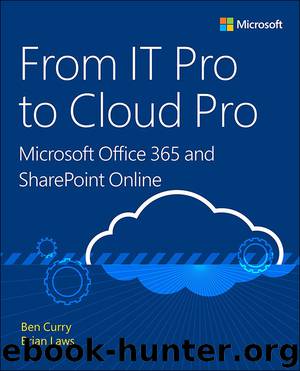From IT Pro to Cloud Pro: Microsoft Office 365 and SharePoint Online (SHARLA SORGE's Library) by Ben Curry & Brian Laws

Author:Ben Curry & Brian Laws
Language: eng
Format: epub
Publisher: Microsoft Press
Published: 2016-07-12T16:00:00+00:00
Nowadays, there’s the expectation that users should be able to get their work done at any time, from anywhere, and from nearly any device. This work can include email, working on documents, collaborating with coworkers, viewing one’s calendar, and so on. The work device can be a mobile device like a phone or a tablet, a company-provided laptop, a PC at home, or an employee-owned laptop as part of a Bring Your Own Device (BYOD) policy. The company’s data is not necessarily contained strictly within its walls anymore. It’s actually quite possible that a lot of company data is distributed across devices in people’s pockets.
This reality poses a real security challenge for companies. What happens if that device is lost or stolen? Is there data on that device that can be accessed by someone else (maybe even someone with harmful intent)? How well protected is that device? If someone turns it on, can that person get direct access to the company systems? These questions might be answerable if the company managed the devices, but that’s rare nowadays. Most office workers use personal devices that might or might not have been “on-boarded.” This can be quite frightening to most organizations, but many feel like there’s not much they can do about it. Quite often, the risk is simply part of the cost of doing business these days.
However, companies can do something to protect themselves and their data: deploy a mobile device management system. An MDM system provides tools companies can use to control who and what has access to data from mobile devices. It enables them to ensure some baseline of protection for both on-boarded (company-managed) and non-on-boarded (personal) devices. This policy usually includes enforcing things like using a PIN, requiring encryption, or deploying a secured browser. Organizations also can provide a way to remotely wipe the device (or a part of the device) if it’s stolen or otherwise compromised. An MDM system can be the next-best thing to a company directly managing a mobile device, and such a system is highly recommended for a distributed workforce that needs to bring sensitive company data down to their devices.
Download
This site does not store any files on its server. We only index and link to content provided by other sites. Please contact the content providers to delete copyright contents if any and email us, we'll remove relevant links or contents immediately.
Test-Driven iOS Development with Swift 4 by Dominik Hauser(7898)
Filmora Efficient Editing by Alexander Zacharias(6555)
The Infinite Retina by Robert Scoble Irena Cronin(6059)
Learn Wireshark - Fundamentals of Wireshark. by Lisa Bock(4388)
Linux Device Driver Development Cookbook by Rodolfo Giometti(4008)
Edit Like a Pro with iMovie by Regit(3820)
Linux Administration Best Practices by Scott Alan Miller(2927)
Linux Command Line and Shell Scripting Techniques by Vedran Dakic & Jasmin Redzepagic(2885)
Mastering PowerShell Scripting - Fourth Edition by Chris Dent(2779)
Creative Projects for Rust Programmers by Carlo Milanesi(2612)
MCSA Windows Server 2016 Study Guide: Exam 70-740 by William Panek(2568)
Docker on Windows by Stoneman Elton(2360)
Kali Linux - An Ethical Hacker's Cookbook: End-to-end penetration testing solutions by Sharma Himanshu(2351)
Hands-On AWS Penetration Testing with Kali Linux by Karl Gilbert(2189)
Hands-On Linux for Architects by Denis Salamanca(2119)
Computers For Seniors For Dummies by Nancy C. Muir(2092)
Programming in C (4th Edition) (Developer's Library) by Stephen G. Kochan(2081)
The Old New Thing by Raymond Chen(2033)
Linux Kernel Debugging by Kaiwan N Billimoria(1812)
